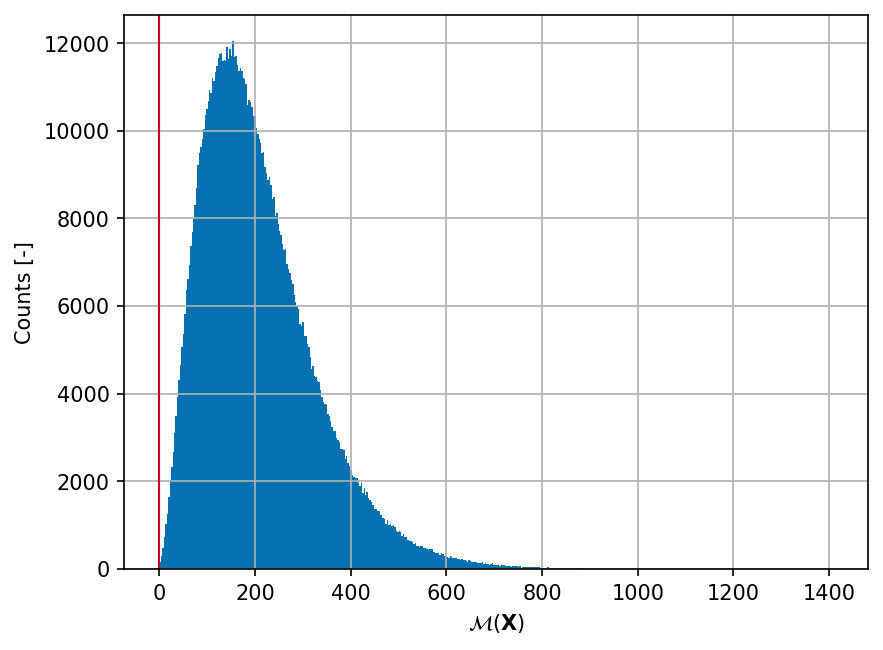Gayton Hat Function
Contents
Gayton Hat Function#
import numpy as np
import matplotlib.pyplot as plt
import uqtestfuns as uqtf
The Gayton Hat function is a two-dimensional function used in [EGLR13] as a test function for reliability analysis algorithms.
The plots of the function are shown below. The left plot shows the surface plot of the performance function, the center plot shows the contour plot with a single contour line at function value of \(0.0\) (the limit-state surface), and the right plot shows the same plot with \(10^6\) sample points overlaid.

Test function instance#
To create a default instance of the test function:
my_testfun = uqtf.GaytonHat()
Check if it has been correctly instantiated:
print(my_testfun)
Name : GaytonHat
Spatial dimension : 2
Description : Two-Dimensional Gayton Hat function from Echard et al. (2013)
Description#
The test function (i.e., the performance function) is analytically defined as follows:
where \(\boldsymbol{x} = \{ u_1, u_2 \}\) is the two-dimensional vector of input variables probabilistically defined further below.
The failure state and the failure probability are defined as \(g(\boldsymbol{x}) \leq 0\) and \(\mathbb{P}[g(\boldsymbol{X}) \leq 0]\), respectively.
Probabilistic input#
Based on [EGLR13], the probabilistic input model for the test function consists of two independent standard normal random variables (see the table below).
my_testfun.prob_input
Name: Echard2013
Spatial Dimension: 2
Description: Input model for the Gayton Hat function from Echard et al. (2013)
Marginals:
| No. | Name | Distribution | Parameters | Description |
|---|---|---|---|---|
| 1 | U1 | normal | [0 1] | None |
| 2 | U2 | normal | [0 1] | None |
Copulas: None
Reference results#
This section provides several reference results of typical UQ analyses involving the test function.
Sample histogram#
Shown below is the histogram of the output based on \(10^6\) random points:
xx_test = my_testfun.prob_input.get_sample(1000000)
yy_test = my_testfun(xx_test)
idx_pos = yy_test > 0
idx_neg = yy_test <= 0
hist_pos = plt.hist(yy_test, bins="auto", color="#0571b0")
plt.hist(yy_test[idx_neg], bins=hist_pos[1], color="#ca0020")
plt.axvline(0, linewidth=1.0, color="#ca0020")
plt.grid()
plt.ylabel("Counts [-]")
plt.xlabel("$\mathcal{M}(\mathbf{X})$")
plt.gcf().set_dpi(150);

Failure probability (\(P_f\))#
Some reference values for the failure probability \(P_f\) from the literature are summarized in the table below.
Method |
\(N\) |
\(\hat{P}_f\) |
\(\mathrm{CoV}[\hat{P}_f]\) |
Source |
Remark |
|---|---|---|---|---|---|
\(5 \times 10^7\) |
\(2.85 \times 10^{-5}\) |
\(2.64 \%\) |
[EGLR13] |
Median over \(100\) replications |
|
\(19\) |
\(4.21 \times 10^{-5}\) |
— |
[EGLR13] |
Median over \(100\) replications |
|
\(19 + \times 10^4\) |
\(2.86 \times 10^{-5}\) |
\(2.39 \%\) |
[EGLR13] |
Median over \(100\) replications |
|
AK+IS1 |
\(19 + 7\) |
\(2.86 \times 10^{-5}\) |
\(2.39 \%\) |
[EGLR13] |
Median over \(100\) replications |
References#
- 1
Adaptive-Kriging importance sampling

